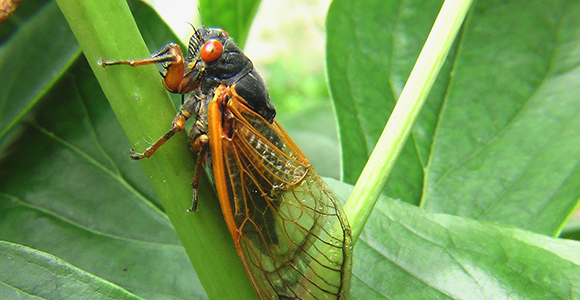They may be a year late to the party, but don't be surprised to see a few stragglers this spring and summer from last year's massive cicada Brood X emergence.

CINCINNATI-It is not uncommon for a small number of the 17-year Brood X cicadas to actually emerge after 18 years, said noted cicada expert Dr. Gene Kritsky Ph.D., dean of behavioral and natural sciences at Mount St. Joseph University.
The soil temperature reaches the critical temperatures in the more southern locations first. The cicadas may start emerging in late April and early May in the southern states, in mid-May in southern Indiana, Ohio, and Maryland, and a week later in northern Indiana, Pennsylvania, and New Jersey.
Why are these stragglers coming out now?
"It is not unusual to have a few of these late arrivals," explained Dr. Kritsky. “They are often not noticed because birds and other predators quickly eat them. Scientists have never actively searched for periodical cicadas during years when no broods are expected, but cicadas have already been reported in Georgia, Washington DC, South Carolina, and Missouri. Thus we need help to determine where they are emerging.”
To help track these late-arriving cicadas, Dr. Kritsky is reaching out to the roughly 200,000 citizen scientists who have downloaded the hugely popular Cicada Safari app, which allows anyone with a Smartphone to search, photograph, video, and help map these off-cycle cicadas.

"Cicada Safari has become an international phenomenon," said its developer, Dr. Gene Kritsky, dean of Behavioral and Natural Sciences at Mount St. Joseph University in Cincinnati. “It was incredibly popular during last year's Brood X emergence. And users can now help us track, photograph, and map the stragglers."
Cicada Safari users contribute to vital scientific research by determining the distribution of the emerging cicadas, enabling scientists to assess the status of cicada broods. The app has proven to be an effective mapping and tracking tool.
"We developed this app because so many people are fascinated by cicadas," said Dr. Kritsky, who has studied, tracked, and written about cicadas throughout his academic career. "This is true citizen science. The photographs and videos submitted to our map are like voucher specimens permitting us to verify the observations, making the maps more useful for future research."
The Cicada Safari app can be downloaded from the Apple App Store or Google Play.
Dr. Kritsky worked in partnership Center for IT Engagement (cITe) at Mount St. Joseph University to create the Cicada Safari App. Dr. Kritsky and the Mount have also launched the CicadaSafari.org website, which offers a virtual trove of cicada facts, history, facts, maps, activities, and more.
A recognized cicada expert, Dr. Kritsky has given hundreds of media interviews, published academic papers on cicadas, and is the author of two books on cicadas. His latest book, "Periodical Cicadas: The Brood X Edition” was published by the Ohio Biological Survey in 2021.
Following are some cicada facts from the Cicada Safari.org website:
- Cicadas emerge after the soil temperature exceeds 64 degrees, which is usually in mid-May.
- Only male cicadas sing through sound-producing structures called tymbals on either side of the abdomen under the wings.
- Cicadas do not eat solid food but do drink fluids to avoid dehydration.
- Cicadas do not sting or bite and do not carry diseases.
- Periodical cicada years are quite beneficial to the ecology of the region. Their egg-laying in trees is a natural pruning that results in increased numbers of flowers and fruits in the succeeding years. Their emergence from the ground turns over large amounts of soil, and after they die, their decaying bodies contribute a massive amount of nutrients to the soil.
- Periodical cicadas are often incorrectly called locusts. Locusts are grasshoppers, and cicadas are more closely related to aphids than grasshoppers.
About Mount St. Joseph University
As a Catholic institution rooted in the values of the Sisters of Charity, Mount St. Joseph University excels at serving the common good. Undergraduate, graduate, and doctoral students at the Mount are inspired to think beyond the classroom and redraw the bounds of what’s possible for their futures. This is accomplished through individualized educational experiences, a safe, secure campus environment, and an all-in commitment from faculty and staff to seeing students reach their highest potential. The Mount fosters life-long learners who serve, care, and contribute to the world beyond their front doors. To find out more visit: www.msj.edu
###

